-

Click on meeting point to see the exact location.
For Historical Tour Every day we meet at 10:00 am sharp, at the Statue of Theseus, which is across the street from the Thissio Metro Station. Although you can just show up, it’s highly recommended to reserve your place in advance as space may be limited during the busy summer months.
Below you’ll find some of the places we may visit. The exact itinerary depends on the guide, the weather, and the people joining the group on that day.
-

Hadrian’s Library
Created by the Roman Emperor Hadrian in 132 AD, it is said to be the largest structure built standing in Athens at that time. On the east side of the library is where the books were kept in the form of scrolls. Emperor Hadrian was an admirer of Greece and wanted to make Athens the cultural capital of the Roman Empire.
-
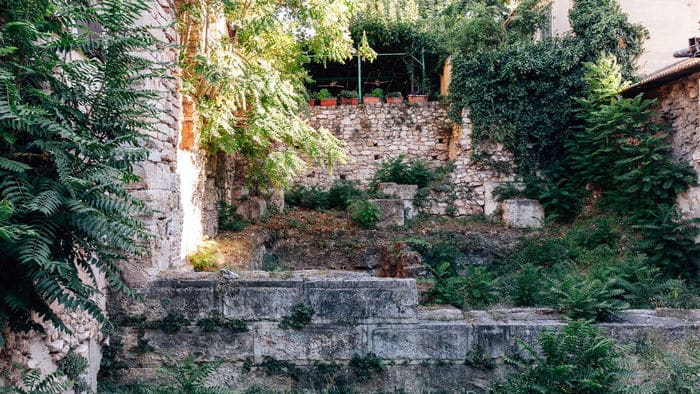
Pantheon
In 1968 they discovered that other than the known Pantheon in Rome there is also a Pantheon in Athens. Again built by Emperor Hadrian, it was built to hold the conference of the Panhellenics, meaning all-Greek. They would gather to discuss different political matters. Later it was used as a sanctuary for the gods explaining the name Pantheon.
-
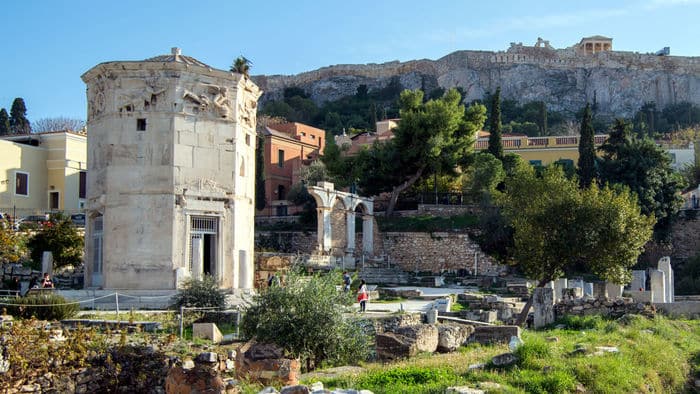
Roman Agora & Tower of Winds
The Roman Agora is said to be the center of Roman Athens. Inside the marketplace is a remarkable tower that is about 8 meters high. It is called the tower of the winds. Used as a clock you can see the sundials placed under the engravings. The engravings are called Aerides and they are the gods of the winds. Depending on the characteristics of the wind are the characteristics engraved of the gods. On the very top there was also a weathervane, used as an early meteorological station.
-

Ancient Agora & Temple of Hephaestus
Located at the ancient center of Athens, the Ancient Agora dates back to the 6th century B.C. Inside the agora you will find the Panathenaic way, a road that leads all the way up to the Acropolis, the first Christian Church called the church of the Apostles, and the Temple of god Hephaestus. When walking through the agora, you are walking in the very steps of ancient philosophers such as Plato and Socrates.
-

Areospagos
Also known as Mars Hill was said to be the Supreme Court of Ancient times. It is named after god Ares the god of war. From there you have a beautiful view of Athens and of course the Acropolis. It is also considered a spiritual rock as the apostle St. Paul first preached to the Athenians about Christianity on that very rock.
-

Acropolis
Host of the great Temple the Parthenon. Built in the 5th century B.C during the golden age of Pericles, the temple was a worship place for the goddess and protector of the city Athena. The Parthenon was built over other temples destroyed by the Persian war and took less than 8 years to built.
On the Acropolis you will also find the temple of Erechtheion dedicated both to goddess Athena and god Poseidon. On the porch you can see the Caryatids, 6 huge maidens which is the most interesting part of the temple. You will also see the temple of the Wingless Nike which was the goddess of Victory.
-

Odeon of Herodes Atticus
An ancient theater located on the southern slopes of the Acropolis. It is a working theater to this day hosting many different types of events during the summer months. Built between 160 – 170AD as a gift to his late wife Rigilla, the Odeon seats 5,000 people in a breath taking open theater environment.
-

Acropolis Museum
The museum is located across from the south entrance to the Acropolis. It holds many artifacts from the Acropolis and the Roman era. The museum focuses on findings from the Acropolis area. The museum is not overwhelming and is easy to go through. It is a must see when visiting Athens. Inside are 5 original maiden statues, the Caryatids, which are stunning.
-
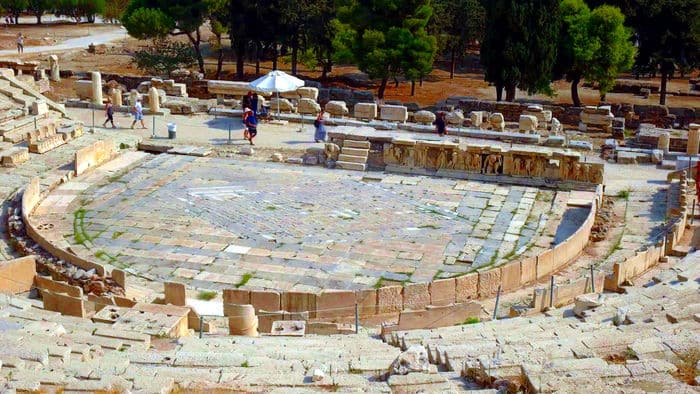
Dionysus Theater
The birth place of tragedy and drama. The very first drama took place in that very theater in the 6th century B.C by Thespis. A place built to worship the god of wine Dionysus it is considered to be the world’s first theater. The original amphitheater seated approximately 17,000 people. The biggest theatrical celebrations called Dionysia took place in this very theater. Later marbles where brought by the Romans to make the modern theater you can see today.
-
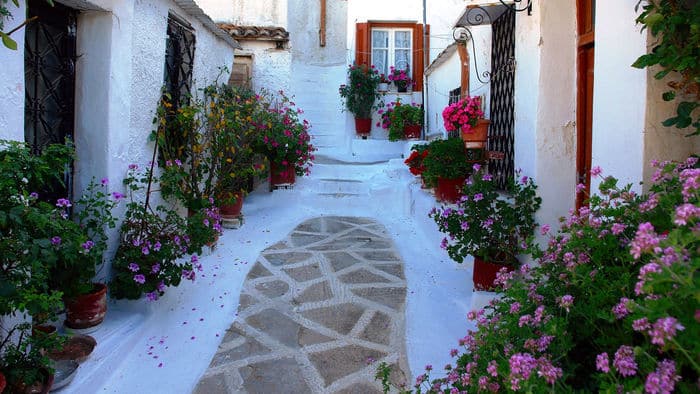
Plaka / Anafiotika
Plaka is the old historical center of Athens and home to many souvenir shops, restaurants and local coffee shops. It looks like a little small village in the center of the very busy city of Athens.
Anafiotika is a tiny neighborhood part of the Plaka area. It is an area where you feel like you are on an island right in the center of the historical city. It is known for its Cycladic style houses where workers from the Anafi island would come to Athens as carpenters or stone and marble workers.
-
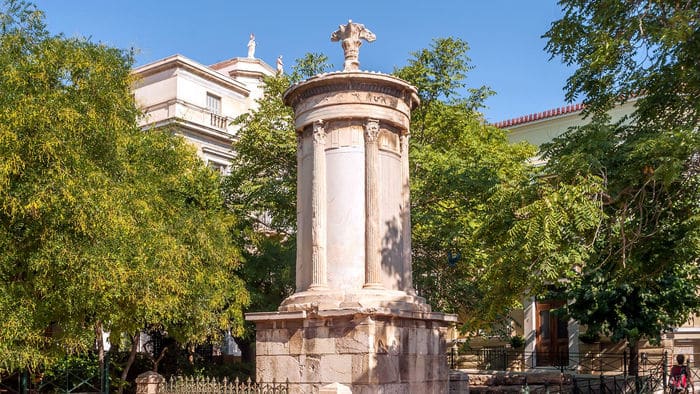
Lysicrates Monument
Built by a wealthy patron of art over 3000 years ago. It was an award trophy given as a first prize in the theatre of Dionysus to the participants.
-

Hadrian’s Arch
It is said to be the entrance to the new city, Hadrianopolis, a city Emperor Hadrian had planned to replace the “old” Athens. The gate resembles a Roman triumphal arch.
-
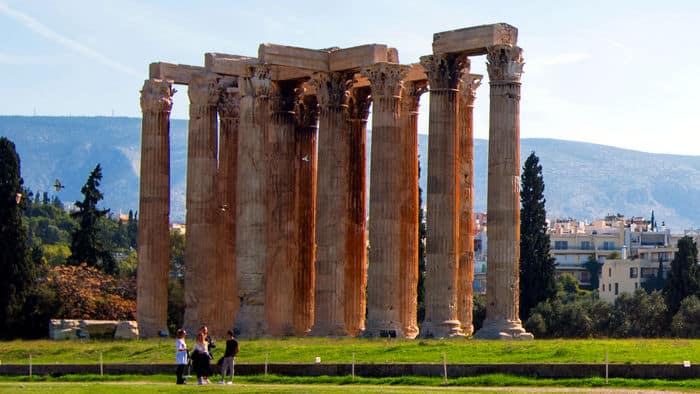
Temple of the Olympian Zeus
Located across from Hadrian’s arch, the temple was a worship ground dedicated to the Olympian Zeus. There were original 104 columns that made the temple but unfortunately there are only 16 left standing today. It is said that you would worship your god first and then pass the gate to enter the city.
-

Panathenaic Stadium
Also known as Kallimarmaro (Good Marble), was originally made out of wood to host the Panthenic games. In 1896 the stadium was rebuilt to host the first modern Olympic games, making it the only stadium in the entire world built entirely from marble.
-
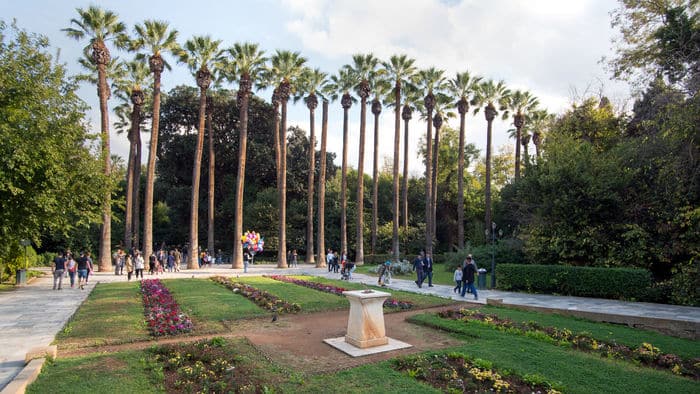
National Gardens
The gardens were built by King Otto as a gift to his wife Queen Amalia in 1838. There where of 500 types of plants and a variety of animals imported to create the beautiful park. The garden is located behind the old palace now known as the Parliament building.
-
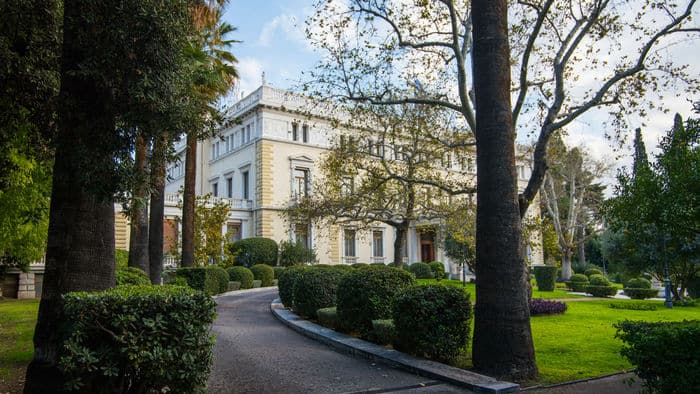
Presidential Palace
It is now the official residence of the current president of Greece. In the past it was the royal palace. Also known as the presidential mansion.
-

Hellenic Parliament / Changing of Guard
Located in Syntagma square at the parliament building is the tomb of the unknown soldier. There you can see the changing of the guards that protect the monument every hour, 24 hours a day. A monument dedicated in memory of soldiers lost in war.
BOOK IT!
"*" indicates required fields


